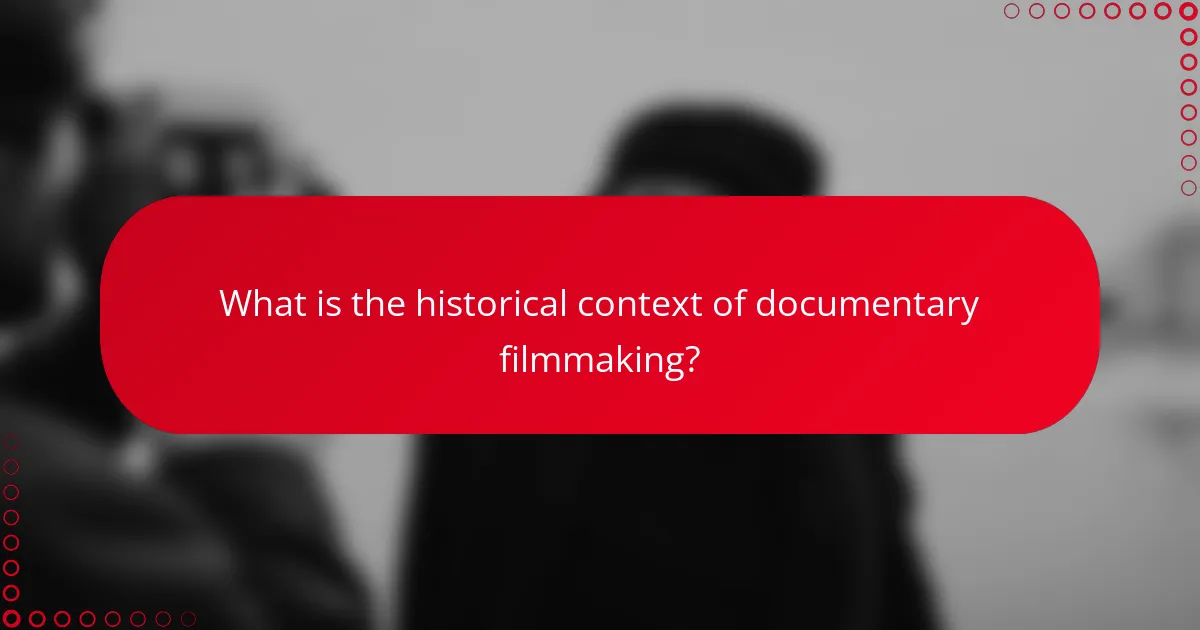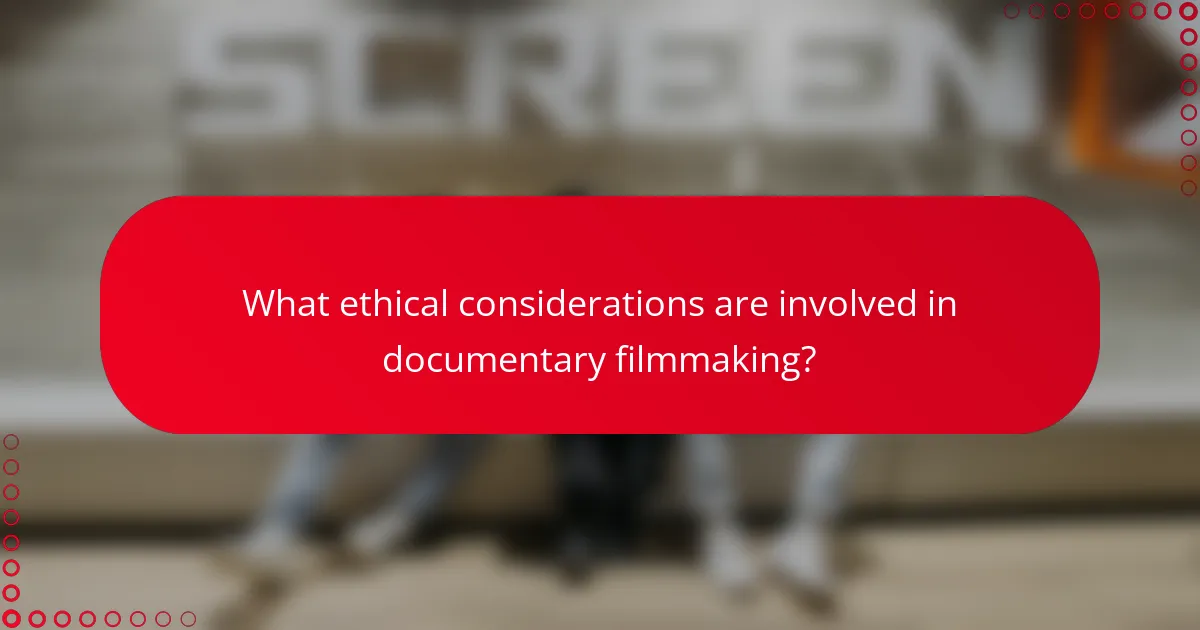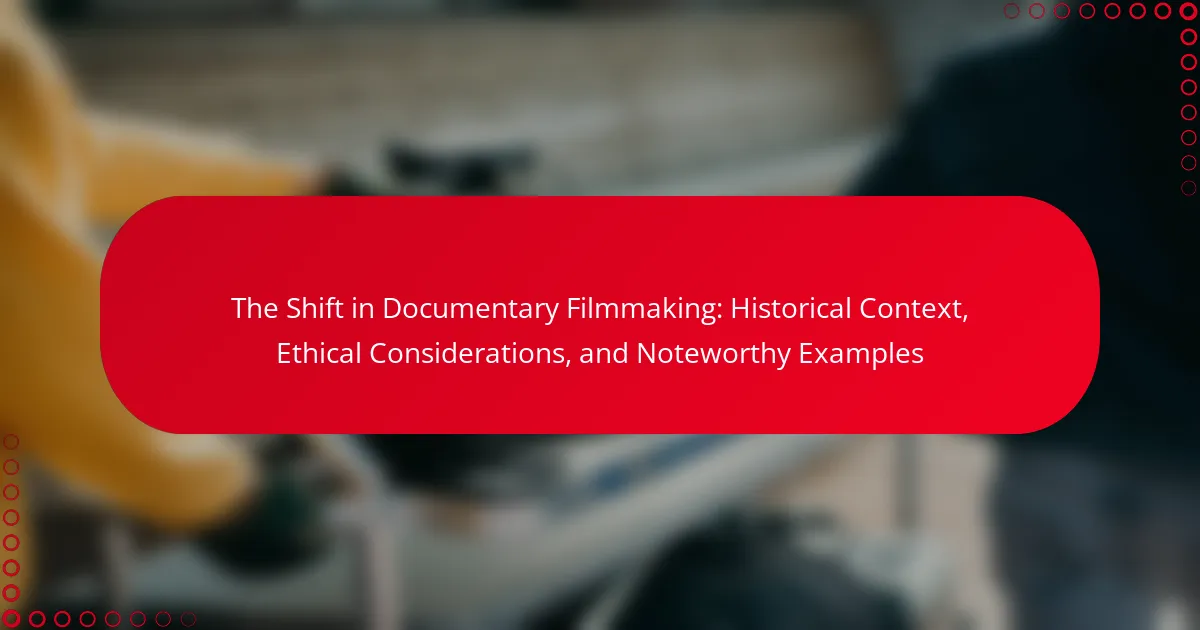Documentary filmmaking is a genre that has evolved significantly since its inception in the early 20th century, marked by influential works like “Nanook of the North” in 1922. The genre has undergone various transformations, including the rise of propaganda films in the 1930s, the direct cinema movement post-World War II, and the impact of digital technology in the late 20th century, which broadened the scope for diverse narratives. Ethical considerations are paramount in this field, encompassing informed consent, accurate representation, and the potential impact of documentaries on communities. Notable examples such as “The Act of Killing,” “13th,” and “Won’t You Be My Neighbor?” illustrate the genre’s capacity to address critical social issues and foster public discourse. This article explores the historical context, ethical responsibilities, and significant works that define the landscape of contemporary documentary filmmaking.

What is the historical context of documentary filmmaking?
Documentary filmmaking originated in the early 20th century. It emerged as a distinct genre with the release of films like “Nanook of the North” in 1922. This film showcased the lives of Inuit people and set a precedent for observational documentary styles. The 1930s saw the rise of propaganda films, particularly during World War II, as governments used documentaries to influence public opinion. The post-war era introduced the direct cinema movement, emphasizing a more immersive, unobtrusive style. Technological advancements, like portable cameras and sound equipment, facilitated this shift. By the late 20th century, documentaries began to explore more diverse subjects and personal narratives. The advent of digital technology further democratized documentary filmmaking, allowing more voices to be heard.
How has documentary filmmaking evolved over the decades?
Documentary filmmaking has evolved significantly over the decades. In the early 20th century, documentaries primarily focused on observational styles and factual reporting. The 1960s introduced direct cinema, emphasizing a fly-on-the-wall approach. By the 1980s, the genre expanded to include more subjective storytelling and personal narratives. The rise of digital technology in the 1990s made filmmaking more accessible, leading to a surge in independent documentaries. Today, streaming platforms have transformed distribution, allowing diverse voices and stories to reach global audiences. This evolution reflects changing societal interests and technological advancements in filmmaking.
What key milestones have defined the history of documentary filmmaking?
The history of documentary filmmaking has been defined by several key milestones. The invention of the motion picture camera in the late 19th century allowed for the first documentaries. The 1922 release of Robert Flaherty’s “Nanook of the North” marked the first feature-length documentary. The 1930s saw the emergence of the “actuality” films, which focused on real events. The 1960s introduced direct cinema and cinema verité, emphasizing observational storytelling. The 1990s brought the rise of the personal documentary, showcasing individual perspectives. The advent of digital technology in the 2000s revolutionized accessibility and production. Today, streaming platforms have transformed how documentaries reach audiences. Each of these milestones has significantly influenced the evolution and perception of documentary filmmaking.
How did technological advancements influence documentary filmmaking?
Technological advancements significantly influenced documentary filmmaking by enhancing accessibility and production quality. The introduction of lightweight cameras in the 1960s allowed filmmakers to capture real-life events more spontaneously. Digital editing software revolutionized post-production, enabling faster and more creative editing processes. Affordable video equipment democratized filmmaking, allowing more voices and stories to be represented. The rise of the internet facilitated distribution, making documentaries accessible to a global audience. Streaming platforms further expanded reach and viewership. These advancements collectively transformed the landscape of documentary filmmaking, fostering innovation and diversity in storytelling.
Why is understanding the historical context important for contemporary filmmakers?
Understanding historical context is crucial for contemporary filmmakers because it informs their storytelling and creative choices. Historical context provides insights into societal norms, cultural movements, and technological advancements that shape narratives. For instance, filmmakers can draw parallels between past events and current issues, enhancing relevance and resonance with audiences. Knowledge of historical filmmaking techniques can also inspire innovative approaches in modern productions. Additionally, understanding historical context helps filmmakers avoid repeating past mistakes, particularly regarding ethical considerations in documentary filmmaking. By recognizing the impact of historical events, filmmakers can create more meaningful and responsible content.
What lessons can modern filmmakers learn from past documentary practices?
Modern filmmakers can learn the importance of authenticity from past documentary practices. Historical documentaries often emphasized truthful representation of subjects. For instance, the direct cinema movement in the 1960s highlighted real-life events without manipulation. This approach fostered trust between filmmakers and audiences. Additionally, early documentarians faced ethical dilemmas regarding consent and representation. Their experiences underscore the need for transparency and ethical standards today. Filmmakers can also learn from the narrative techniques used in past works. Engaging storytelling was pivotal in capturing audience interest. Lastly, the significance of context and cultural sensitivity is evident in historical documentaries. Understanding these elements can enhance modern documentary filmmaking.
How do historical documentaries reflect societal changes?
Historical documentaries reflect societal changes by illustrating the evolution of cultural narratives and collective memory. They capture significant events, ideologies, and social movements, providing context for contemporary issues. For example, documentaries like “The Civil War” by Ken Burns highlight the impact of the Civil War on American society. They showcase how historical perspectives shift over time, influenced by current social values. Additionally, documentaries often include interviews and archival footage, offering firsthand accounts that resonate with audiences. This approach fosters a deeper understanding of past injustices and triumphs, prompting societal reflection and dialogue. The portrayal of marginalized voices in films like “13th” by Ava DuVernay further emphasizes changing societal attitudes towards race and justice. Thus, historical documentaries serve as mirrors, revealing the complexities of societal transformations.

What ethical considerations are involved in documentary filmmaking?
Ethical considerations in documentary filmmaking include informed consent, representation, and accuracy. Filmmakers must obtain informed consent from participants before filming. This ensures that individuals understand how their stories will be portrayed. Representation is crucial; filmmakers should depict subjects authentically and avoid stereotypes. Accuracy in presenting facts and context is essential to maintain credibility. Misrepresentation can lead to harm or misinformation. Additionally, filmmakers should consider the potential impact of their work on communities and individuals involved. Balancing artistic vision with ethical responsibility is vital in documentary filmmaking. These considerations are supported by ethical guidelines established by organizations like the International Documentary Association.
What are the primary ethical dilemmas faced by documentary filmmakers?
Documentary filmmakers face several primary ethical dilemmas. These include issues of representation, consent, and exploitation. Filmmakers must ensure that their subjects are portrayed accurately and respectfully. Misrepresentation can lead to harmful stereotypes and misinformation. Consent is crucial, particularly when dealing with vulnerable populations. Filmmakers must obtain informed consent from participants, which can be complex in sensitive situations. Exploitation arises when filmmakers benefit financially or artistically from the hardships of their subjects. This raises questions about the morality of profiting from someone else’s struggles. Additionally, filmmakers often grapple with the balance between storytelling and truth. They must decide how to present reality without distorting it for dramatic effect. These dilemmas highlight the responsibilities filmmakers have to their subjects and audiences.
How does the representation of subjects impact ethical decisions?
The representation of subjects significantly impacts ethical decisions in documentary filmmaking. Accurate representation fosters trust and authenticity. When filmmakers depict subjects truthfully, it respects their dignity and agency. Misrepresentation can lead to exploitation and harm. Ethical decisions hinge on how subjects are portrayed. For example, the portrayal of marginalized communities can perpetuate stereotypes or empower them. Research by Bill Nichols in “Introduction to Documentary” emphasizes the ethical responsibility of filmmakers in representation. Ethical filmmaking requires a commitment to honest and respectful subject portrayal.
What role does consent play in documentary filmmaking ethics?
Consent is a fundamental aspect of documentary filmmaking ethics. It ensures that subjects understand and agree to their participation in the film. Documentarians are ethically obligated to respect the autonomy of their subjects. This includes obtaining informed consent before filming begins. Informed consent involves clearly communicating the purpose of the documentary, potential risks, and how the footage will be used. Failure to secure consent can lead to ethical violations and legal repercussions. Historical cases, such as the controversy surrounding “The Act of Killing,” highlight the importance of consent in ethical filmmaking practices. Consent fosters trust and transparency between filmmakers and subjects.
How can filmmakers navigate ethical challenges in their work?
Filmmakers can navigate ethical challenges by adhering to established guidelines and principles. They should prioritize transparency in their storytelling. This includes disclosing funding sources and potential conflicts of interest. Filmmakers must also obtain informed consent from subjects. This ensures that individuals understand how their stories will be used. Additionally, filmmakers should engage in responsible representation. This means accurately portraying the communities and individuals featured in their work. Ethical training and workshops can enhance filmmakers’ awareness of these issues. Historical examples, such as the controversy surrounding “The Act of Killing,” highlight the consequences of ethical oversights. By learning from past mistakes, filmmakers can make more informed choices in their projects.
What best practices should filmmakers adopt to ensure ethical integrity?
Filmmakers should adopt transparency, respect for subjects, and adherence to legal standards to ensure ethical integrity. Transparency involves clearly communicating intentions and processes to participants. This builds trust and ensures informed consent. Respect for subjects includes portraying them accurately and sensitively. Filmmakers must avoid exploitation and misrepresentation. Adhering to legal standards protects both the filmmaker and subjects from potential liabilities. Following these practices aligns with ethical guidelines established by organizations such as the International Documentary Association. These guidelines emphasize the importance of ethical storytelling in documentary filmmaking.
How can transparency enhance ethical standards in documentaries?
Transparency enhances ethical standards in documentaries by fostering trust between filmmakers and audiences. When filmmakers openly disclose their methods and intentions, viewers can assess the authenticity of the content. This practice reduces the risk of manipulation or misrepresentation of facts. For example, the documentary “The Act of Killing” included behind-the-scenes footage that revealed the filmmakers’ interactions with subjects. This transparency allowed viewers to critically evaluate the ethical implications of the film. Moreover, adherence to transparency can lead to accountability in storytelling. Documentarians who are upfront about biases and funding sources promote a more honest dialogue with their audience. This ultimately upholds the integrity of the documentary genre.

What are some noteworthy examples of impactful documentaries?
Noteworthy examples of impactful documentaries include “The Act of Killing,” “13th,” and “Won’t You Be My Neighbor?” “The Act of Killing” explores the Indonesian mass killings of 1965-66. It challenges perpetrators to reenact their crimes, prompting reflection on violence. “13th” examines the intersection of race, justice, and mass incarceration in the U.S. It highlights systemic racism and the prison-industrial complex. “Won’t You Be My Neighbor?” profiles Fred Rogers and his influence on children’s television. It emphasizes kindness and empathy in a divided society. Each documentary has sparked conversations and increased awareness on critical social issues.
What documentaries have significantly influenced public perception?
“Documentaries that have significantly influenced public perception include ‘An Inconvenient Truth,’ ‘Blackfish,’ and ‘The Act of Killing.’ ‘An Inconvenient Truth’ raised awareness about climate change, contributing to a global conversation on environmental issues. It presented scientific data and personal narratives from former Vice President Al Gore. This documentary played a crucial role in shifting public attitudes towards sustainability. ‘Blackfish’ highlighted the ethical concerns surrounding orca captivity in marine parks. It spurred widespread criticism of SeaWorld and led to changes in policies regarding marine life captivity. ‘The Act of Killing’ challenged viewers to confront the Indonesian mass killings of 1965-66. It provided a unique perspective by allowing perpetrators to reenact their crimes. This documentary prompted discussions about historical memory and accountability.”
How did these documentaries address pressing social issues?
Documentaries addressed pressing social issues by highlighting systemic injustices and raising public awareness. They often focused on topics like poverty, racism, and environmental degradation. By presenting real-life stories, these films humanized complex issues. For example, documentaries such as “13th” explored racial inequality in the criminal justice system. They used statistics and expert interviews to support their claims. This approach encouraged viewers to engage with the subject matter. Additionally, documentaries often sparked conversations and inspired activism. They served as a catalyst for social change by mobilizing communities and influencing policy discussions.
What storytelling techniques made these documentaries stand out?
Innovative storytelling techniques that made these documentaries stand out include immersive narratives, character-driven plots, and unique visual styles. Immersive narratives engage viewers by placing them directly in the experience. Character-driven plots create emotional connections through relatable subjects. Unique visual styles enhance the storytelling by providing a distinct aesthetic. These techniques allow for deeper audience engagement and a more impactful message. For instance, the use of archival footage in documentaries adds authenticity and historical context. Additionally, personal anecdotes from subjects can evoke empathy and understanding. These storytelling methods contribute significantly to the overall effectiveness of the documentaries.
What recent documentaries are reshaping the landscape of filmmaking?
Recent documentaries reshaping filmmaking include “American Factory,” “The Social Dilemma,” and “My Octopus Teacher.” “American Factory,” produced by Barack and Michelle Obama’s Higher Ground Productions, explores the clash of cultures in a Chinese factory in Ohio. It won the Academy Award for Best Documentary Feature in 2020. “The Social Dilemma” examines the dangerous impact of social networking, featuring tech experts from companies like Google and Facebook. It has sparked discussions about digital ethics and responsibility. “My Octopus Teacher” tells the story of a filmmaker forging a bond with an octopus in a South African kelp forest. This documentary won the Academy Award for Best Documentary Feature in 2021. These films demonstrate innovative storytelling techniques and address pressing social issues, influencing both audiences and future filmmakers.
How do these contemporary works reflect current societal challenges?
Contemporary documentary works reflect current societal challenges by addressing pressing issues such as climate change, racial inequality, and mental health. These films often highlight real-life struggles faced by marginalized communities. For example, documentaries like “13th” explore systemic racism and mass incarceration in the United States. Similarly, “Our Planet” raises awareness about environmental degradation and its impact on biodiversity. By showcasing personal stories, these works foster empathy and understanding among viewers. They also serve as a call to action, urging audiences to engage with these societal issues. The use of accessible platforms like streaming services has amplified their reach, making these critical conversations more widespread.
What innovative approaches are being used in recent documentaries?
Recent documentaries are utilizing innovative approaches such as interactive storytelling and immersive technology. These methods enhance viewer engagement and create a more personalized experience. For example, virtual reality (VR) is being used in projects like “The Displaced,” allowing audiences to experience the lives of refugees firsthand. Additionally, data visualization techniques are being employed to present complex information clearly and effectively. This approach can be seen in documentaries like “Our Planet,” which uses stunning visuals to convey environmental data. Furthermore, collaborative filmmaking is becoming more common, involving subjects in the storytelling process. This method fosters authenticity and diverse perspectives, as demonstrated in “Won’t You Be My Neighbor?” Overall, these innovative approaches are reshaping how stories are told in the documentary genre.
What practical tips can aspiring documentary filmmakers follow?
Aspiring documentary filmmakers should focus on storytelling, research, and technical skills. Strong narratives engage audiences and convey messages effectively. Researching subjects thoroughly enhances credibility and depth. Filmmakers must also understand their equipment and editing software. Mastering camera techniques improves visual storytelling. Networking with industry professionals can open opportunities. Attending film festivals provides exposure and inspiration. Lastly, seeking feedback helps refine skills and projects.
How can filmmakers effectively research and plan their documentary projects?
Filmmakers can effectively research and plan their documentary projects by following structured steps. First, they should define their documentary’s core theme or question. This clarity helps in guiding the research process. Next, conducting thorough background research is essential. This includes reviewing existing literature, films, and articles related to the topic. Filmmakers can also engage with experts and communities connected to the subject. Interviews and discussions can yield valuable insights and perspectives.
Additionally, creating a detailed outline of the documentary is crucial. This outline should include key points, potential interview subjects, and visual elements. Filmmakers should also consider logistics, such as location scouting and budgeting. Finally, developing a timeline for the project helps in organizing tasks and meeting deadlines. By following these steps, filmmakers can ensure a comprehensive approach to their documentary research and planning.
What strategies can enhance storytelling in documentaries?
Utilizing narrative structure enhances storytelling in documentaries. A clear beginning, middle, and end can guide the audience through the story. Incorporating character development engages viewers emotionally. This fosters a connection with the subjects portrayed. Visual storytelling techniques, such as strong imagery and cinematography, enhance the narrative impact. Effective use of sound design and music can evoke emotions and set the tone. Additionally, integrating interviews adds personal perspectives and authenticity to the narrative. Research indicates that documentaries with compelling stories retain viewer attention better, as demonstrated by studies on audience engagement in visual media.
The main entity of this article is documentary filmmaking, which has undergone significant shifts in its historical context, ethical considerations, and notable examples. The article outlines the evolution of documentary filmmaking from its origins in the early 20th century to contemporary practices influenced by technological advancements and changing societal values. Key milestones, ethical dilemmas, and storytelling techniques are discussed, along with impactful documentaries that have shaped public perception and sparked social change. The article emphasizes the importance of understanding historical context and ethical integrity in creating meaningful documentary content.
